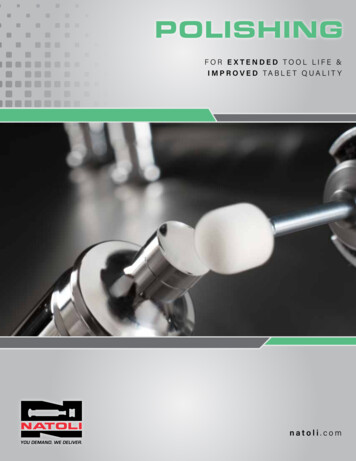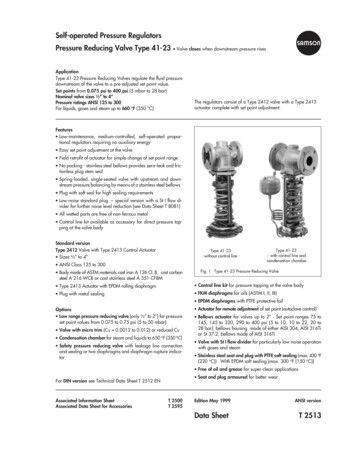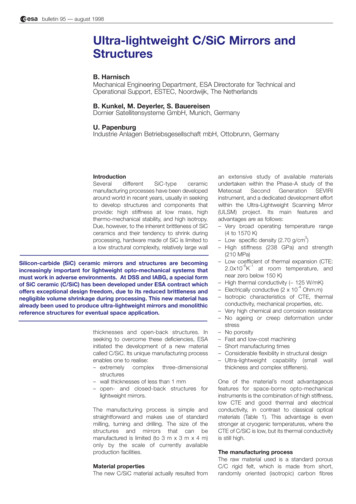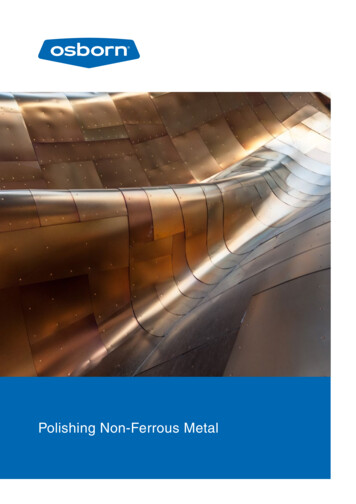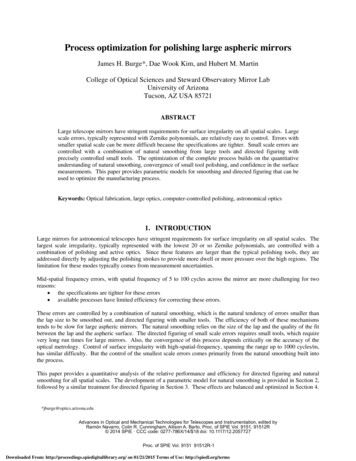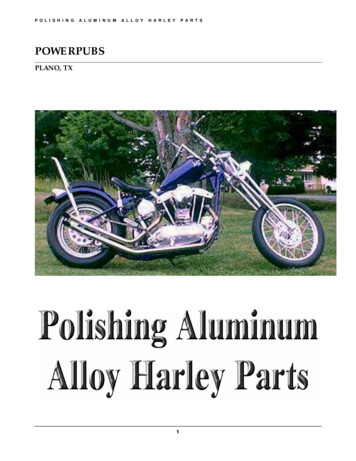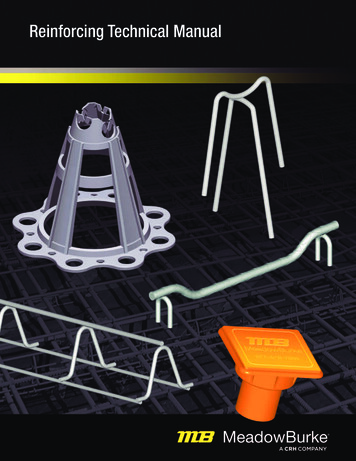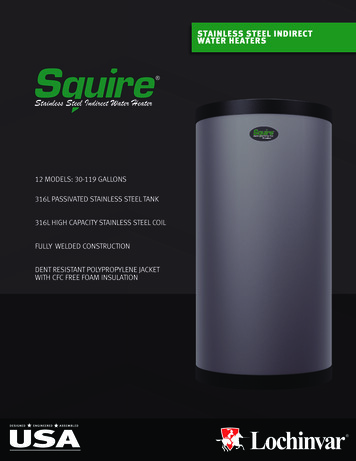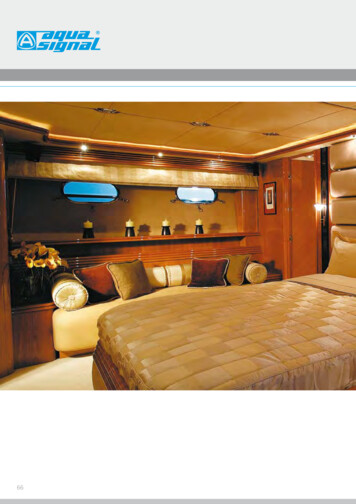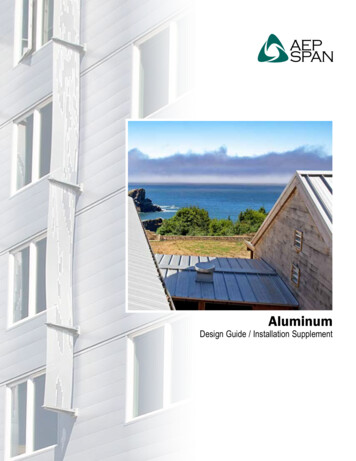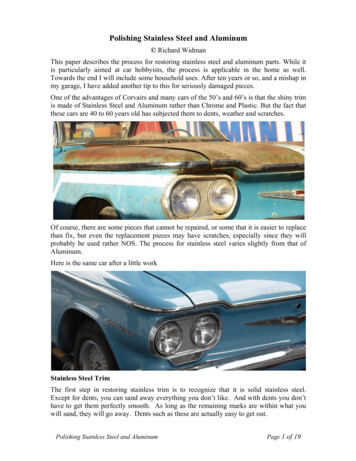
Transcription
Polishing Stainless Steel and Aluminum Richard WidmanThis paper describes the process for restoring stainless steel and aluminum parts. While itis particularly aimed at car hobbyists, the process is applicable in the home as well.Towards the end I will include some household uses. After ten years or so, and a mishap inmy garage, I have added another tip to this for seriously damaged pieces.One of the advantages of Corvairs and many cars of the 50’s and 60’s is that the shiny trimis made of Stainless Steel and Aluminum rather than Chrome and Plastic. But the fact thatthese cars are 40 to 60 years old has subjected them to dents, weather and scratches.Of course, there are some pieces that cannot be repaired, or some that it is easier to replacethan fix, but even the replacement pieces may have scratches, especially since they willprobably be used rather NOS. The process for stainless steel varies slightly from that ofAluminum.Here is the same car after a little workStainless Steel TrimThe first step in restoring stainless trim is to recognize that it is solid stainless steel.Except for dents, you can sand away everything you don’t like. And with dents you don’thave to get them perfectly smooth. As long as the remaining marks are within what youwill sand, they will go away. Dents such as these are actually easy to get out.Polishing Stainless Steel and AluminumPage 1 of 19
The first step is to find two materials that are firm, but not hard. This avoids stretching themetal. I had a scrap of thick leather left from my BBQ apron, so it became my basesurface. I then took a small scrap of wood that I could easily form or shape on the grinderto match the surface of each piece. I placed the trim piece on the leather, the shaped stickabove, and hit the stick with a hammer. I thought it would be easy to damage, but it turnedout easy. A few hits, inspection, more hits, more inspection.As it approached “straight” I used a piece of sandpaper on a block of wood to sand or“block” across the spot, identifying high and low spots.Once the dents were out, it was time to sand. There are some air sanders that might bebetter at this, but I did not have any and decided to sand by hand after trying a mini-grinderwith sandpaper discs. It made too many swirls. Hand sanding is really not that hard.Polishing Stainless Steel and AluminumPage 2 of 19
Here is a close-up of part of the upper windshield trim before I started.I first tried 150 grit paper, and quickly found that while it took damage off quickly, it leftbig scratches that were hard to get out. Jumping up to 320 was taking too long to get thedeep pitting out, so I settled on a first pass with 220 grit. It might have been better to usewater, but I did not have any waterproof gloves. I do recommend gloves, and used the onesyou see. These saved a few knuckles on the grinder.On areas where there had been dents, sanding with a little piece of wood behind thesandpaper took out the high points. Then it was just straight sanding, sometimesconcentrating on deeper areas.Several people told me just to polish, nothing more. I originally tried that and this is whatI found after polishing my gas filler trim without sanding first. This had obviously been hitby many gas pump nozzles over the years.I did not want polished scratches, so I decided to try sandpaper and developed the rest ofthe technique.Polishing Stainless Steel and AluminumPage 3 of 19
Once I thought I had gotten rid of the big pitting and scratches, I moved to 360 or 400 gritpaper. If I discovered any deeper scratches, sometimes I went back to 220 for a fewminutes.When I had a smooth, uniform surface, I moved up to 500 and then 600 grit paper. At thispoint the pieces started looking pretty new, and at first, I started polishing from here, butthen I decided to try 1000 grit paper before using the polishing wheel, and this saved a lotof time and mess on the polisher.I recommend safety glasses to keep the polishing compound and cotton threads out of youreyes. The gloves also helped keep a good grip on the parts.This is a small Craftsman grinder with a polishing wheel. I trieddifferent polishing pastes and compounds, finally realizing that thewhite polishing stick was the best at taking it to a good shinewithout caking, followed by a red polishing stick for the mirrorfinish.This is the finished gas filler trim that is shown at the beginningwhere first I tried polishing without sanding.Polishing Stainless Steel and AluminumPage 4 of 19
Here is the final polished upper windshield trim piece we started with in the first close-up.The vertical trim around the roof and windows had a lot less scratches, but the weather hadtaken its toll. Here is a comparison of two pieces from the roof trim, one before and oneafter polishing. There were only a few spots on these that required the 220 grit paper. Forthe most part I started with 360. The reflection is of my jeans and belt buckle.Polishing Stainless Steel and AluminumPage 5 of 19
Once all pieces were sanded and polished, I added a little wax and put the pieces asideuntil the body was repaired and painted. Here is the finished set of belt trim.Here is the finished set of roof and windshield trim.Sharp dentsAs I progressed and became more comfortable with the process, I found that those dentsthat would not come out with the wood and hammer could be removed with a wide, flatscrewdriver and the hammer. It helps to grind both edges/ends of the screwdriver blade sothat there is no deep dent where your hammer stroke ends.Here we have part of my replacement rear piece before doing anything with it.The wood can take out the big dents like the one in the upper piece in this picture (left rearfender).Polishing Stainless Steel and AluminumPage 6 of 19
In this picture you can see how the wood was effective on that upper piece.But the ones in the creases need more direct impact, so the screwdriver and hammer on theleather strip take them out. This just takes a little patience and practice.The next step is sanding fairly aggressively with 220 grit paper wrapped around thewooden stick. The object here is to eliminate any high points and discover any low pointsthat remain. If you discover any, just go back to the hammer.Once it is sanded flat, or following the contour, and no high or low spots remain, it is timefor the 360 grit sandpaper. I used this first with the stick to make sure I had everythingstraight and then finished up with finer paper.Polishing Stainless Steel and AluminumPage 7 of 19
Here you can see how it looks after sanding with 500 grit paper. It is straight and smooth,although not shiny.The next step is to sand with the 1000 grit paper and polish as before with the polisher andwhite compound, then red compound for a finer shine.Here is the same piece, polished and installed on the back of the car.Polishing Stainless Steel and AluminumPage 8 of 19
Thirteen years after restoring all of this, a house painter got careless and slammed twocorners of my Corvair with a ladder. This is how he left that corner.Since this was a very hard hit, and located on the curve, where just hammering mightstraighten it lengthwise or not be able to get the right depth, I cut a grove in a piece ofwood to the depth and approximate shape of the piece.With this groove I was able to use the wooden stick, ground to different angles, and myslightly rounded screwdriver (just take the corners back a couple of mm), to return thepiece to its proper form, sand it, and polish it, as you can see in the next picture.Polishing Stainless Steel and AluminumPage 9 of 19
AluminumAlthough aluminum is also pure metal and can be sanded, there are two problems with itsrestoration:1. The anodized coating that comes from the factory and protected it during its firstyears. This is very hard and resists polishing.2. Aluminum is soft. This makes corrosion deeper. Additionally, the aluminum sillplates are located where they get kicked and stay wet, often with salt or othercompounds. Finally, sill plates are the most neglected since they are not seen.Because it is soft, I was originally afraid to sand the aluminum parts. I started with theheadlight bezels, and soon found that it was very time consuming to get through theanodizing.Here is my first attempt at polishing without removing the anodizing.Polishing Stainless Steel and AluminumPage 10 of 19
Looking on the internet I found a recommendation to usecaustic soda (drain cleaner) to remove the anodizing. Thisstarts bubbling and I used a brush to keep fresh solutionwhere it was needed. It takes between 1 and 2 tablespoonsper gallon of water, with only about 10 to 15 minutessoaking.Once I had the anodizing off, I tried the sandpaper andfound it best to start on the bezels with 600 grit paper. Thisquickly took off the dull finish and began to put a shine onit.I found that polishing directly from the 600 grit paper left a lot of clogging of the polishingwheel, so I followed up the 600 paper with 1000 grit paper before polishing.The bezels have small grooves that required the use of a little ice cream spoon on thesandpaper to get into the grooves, followed up by the white polishing stick and a polishingwheel on my mini-grinder.Polishing Stainless Steel and AluminumPage 11 of 19
The bezels have a lot of curves, so I combined the polishing wheel on the grinder for theoutside and one on my drill for the inside, clamping the bezels to the table.Then I coated the finished bezels with a clear thermo-plastic spray paint to replace theoriginal anodizing and protect the finish.Polishing Stainless Steel and AluminumPage 12 of 19
Putting these together with the stainless headlight rims that I straightened and polished, aswell as the headlight housings that I sandblasted, patched, and painted, the headlights areready for assembly on the car.I also used my wood and leather to straighten the galvanized bowls for the headlights, thensanded the rust and plastic coated them. If it had been available I would have used a zincspray on the galvanized parts.Polishing Stainless Steel and AluminumPage 13 of 19
Aluminum Sill PlatesThe sill plates presented another problem. Heavy sanding of the corrosion would havetaken out the stamped design, so I had to compromise how far I would sand certain areas.Here are a couple of them in their original condition.Here is a close-up that shows some of the deeper corrosion.I did some sanding with an orbital sander, but in the end found that I had more controlusing my hands. There were a few areas where I used 150 grit, but for the most part Istarted with 220, then 360 or 400, then 500 and 600 before finishing with 1000.Once everything was sanded and basically polished with 1000 grit paper, I startedpolishing with an abrasive polishing paste. Since these are long and flimsy, I found iteasier to clamp them to the table and use the polishing wheel on my drill.Polishing Stainless Steel and AluminumPage 14 of 19
The polished sill looks like this before coating with clear plastic spray.Here is the finished set of four along side the four steel sills that go underneath them.Those have been sandblasted, patched where rusted through, rust-proofed and painted.Polishing Stainless Steel and AluminumPage 15 of 19
Here is the can of clear plastic that I used to protect all of the aluminum partsafter polishing. The stainless parts do not need it as they will maintain theirshine as they are polished regularly with the rest of the car.There are probably many similar products out there, but this was availableand gave me a nice clear finish and dried quickly without allowing dust toset in. I don’t remember the brand, but it had a Miami address.These are the basics. When you have more tools or materials available thereare probably some short cuts, but in reality it took me less than one day forthe belt trim, another for the roof and windshield trim, one more (or maybe just anafternoon) for the headlights, and maybe two days for the sill plates.In the process I bought out all of the 400, 500, 600, and 1000 grit sandpaper from at leastfour hardware and paint stores. Not that it was a lot of sandpaper, but the local stores herein Bolivia normally stock two or three sheets of each.The rest of the process of my restoration of my Corvair is posted on my web site atwww.widman.biz/CorvairPolishing Stainless Steel and AluminumPage 16 of 19
Some aluminum products are not anodized.Those do not require the first step. Some donot normally have a flat finish to sand. Hereare the manifolds of my Renault Dauphine.The intake manifold is cast aluminum with acast finish, so all it took was buffing with awire wheel, applying Meguiar’s Mag andAluminum Polish to the finished product toprotect it from the elements. (The exhaustmanifold is painted with Rustoleum HiTemp BBQ paint.)Other parts are cast aluminum but should be smooth and shiny. Here are the rear grills ofmy Renault Dauphine. They required some straightening and welding, then removal ofpaint and casting marks. The makings from the mold (50 years ago) were severe on all ofthe bars.Polishing Stainless Steel and AluminumPage 17 of 19
This in this case, I usedthe wire wheel toremove most of thepaint, then, since I wasdealing with solid castaluminum that was notanodized, I used 150grit paper wrappedaround a piece of woodthat I ground to where itfit in the slots androunded ends. Then,when the casting andwelding marks wereremoved, I used 220grit paper, then 360,400, 500 and then 1000grit before buffing withthe cotton wheel and polishing compound.I decided that I would treat these with the Meguiar’s polish, as it is producing a very nicefinal finish and I can apply it easily as needed.As I move on with therestoration of thisRenault, I will bepracticing my stainlessrestoration on thesefront and rear windowtrim pieces. They areall scratched andpitted.Here is the restored piece of windshield trim shown abovePolishing Stainless Steel and AluminumPage 18 of 19
Household tipsMy daughter has a nice set of stainless dinnerware, but most of the spoons had made theirway into the dishwasher, probably with the help of the twin toddlers. So, one night whilevisiting, as we watched a movie, I decided to restore the damaged pieces. First, I used asteel nail file to eliminate the sharp or malformed edges, approximating the right shape forthe spoon. Once that was done, I used her emery board to eliminate the remainingscratches, moving on to the finest to leave a nice shine. By the end of the movie the wholeset was restored.The documentation of each of my car restorations is posted here:https://www.widman.biz/cars/For more automotive maintenance tips, check with us at www.widman.bizPolishing Stainless Steel and AluminumPage 19 of 19
This is a small Craftsman grinder with a polishing wheel. I tried different polishing pastes and compounds, finally realizing that the white polishing stick was the best at taking it to a good shine without caking, followed by a red polishing stick for the mirror finish. This is th
